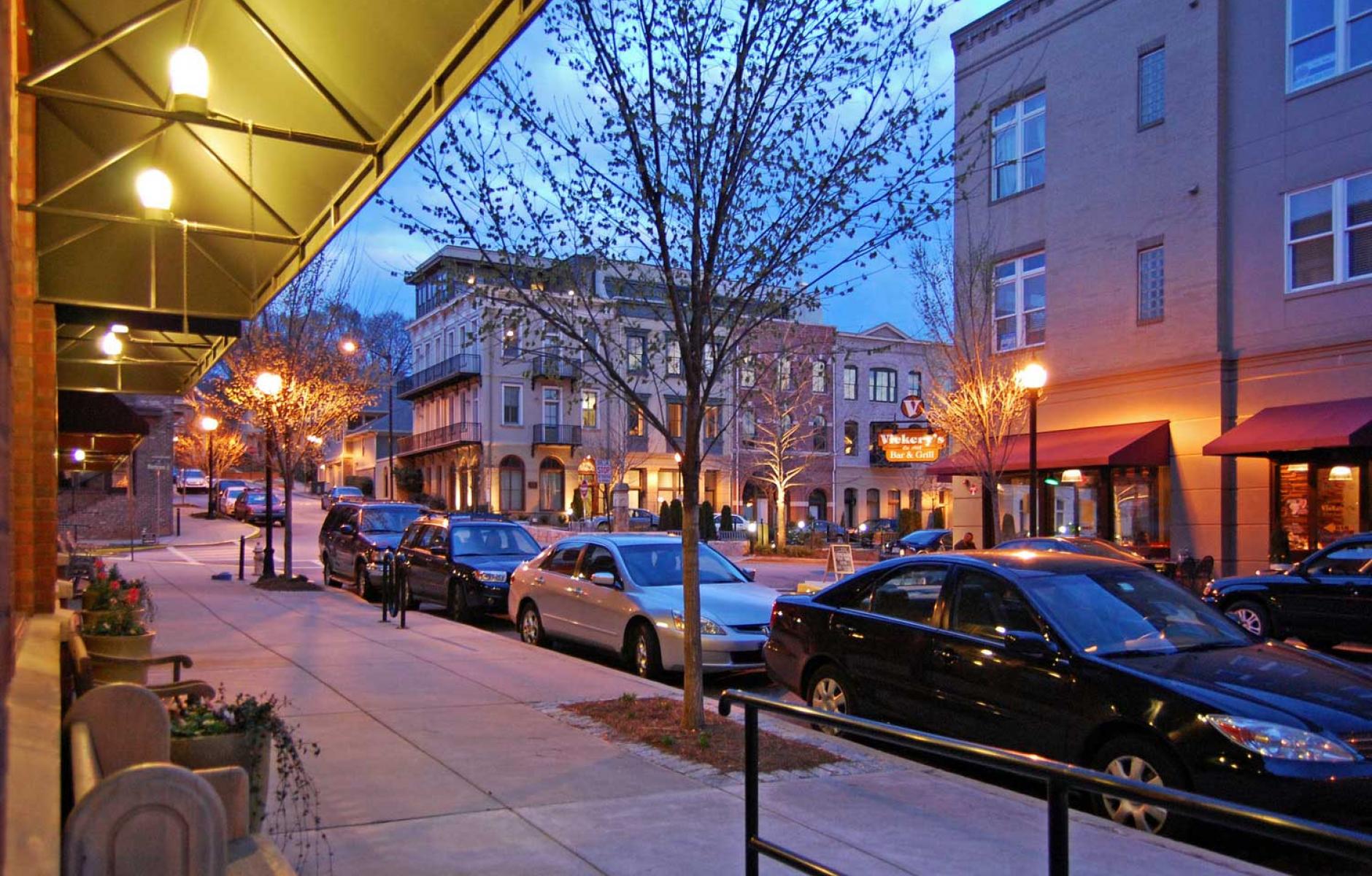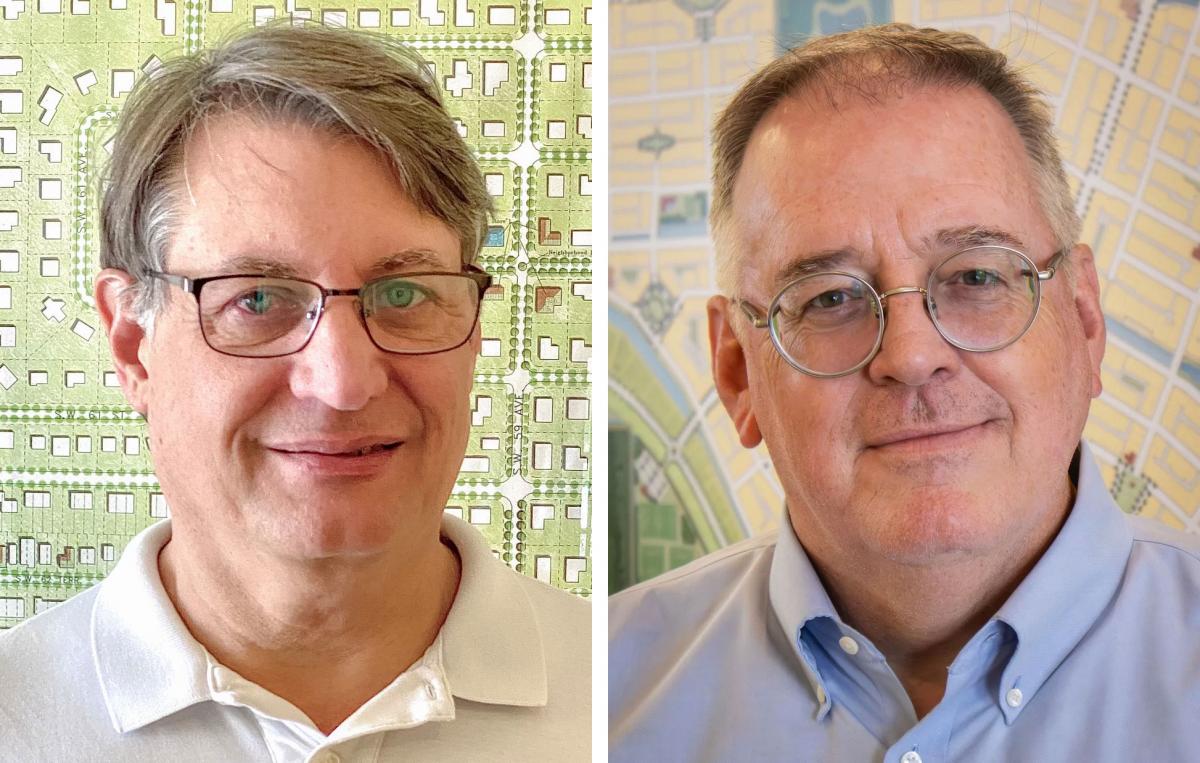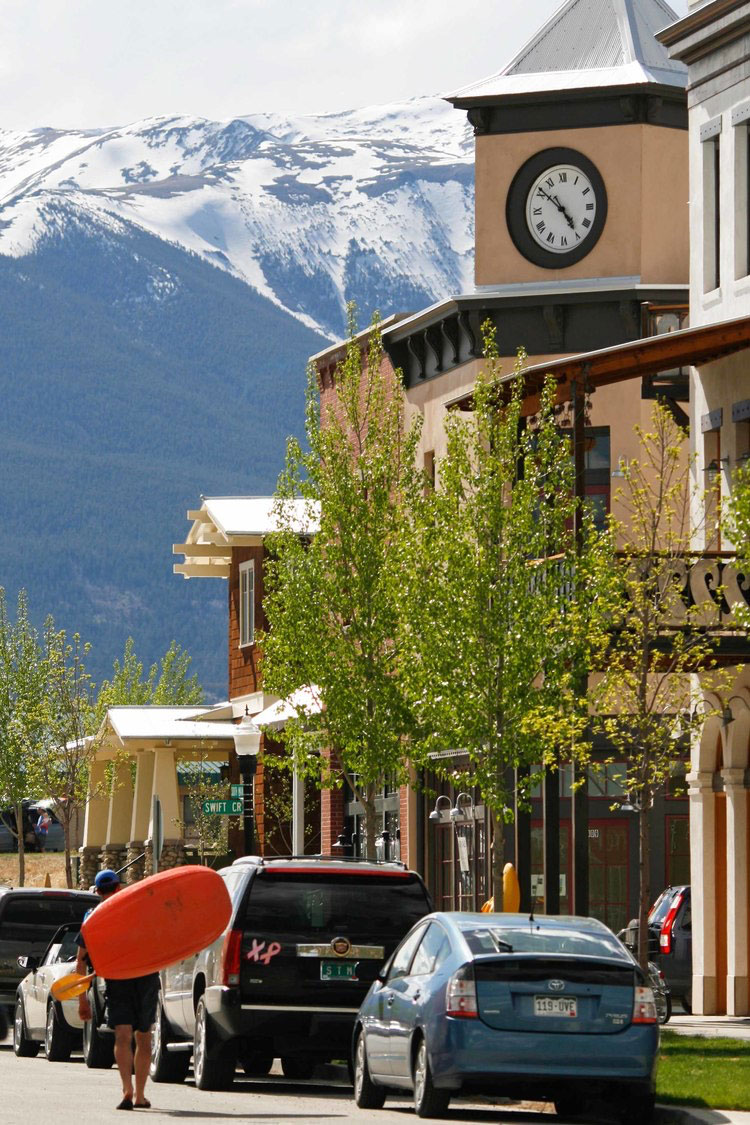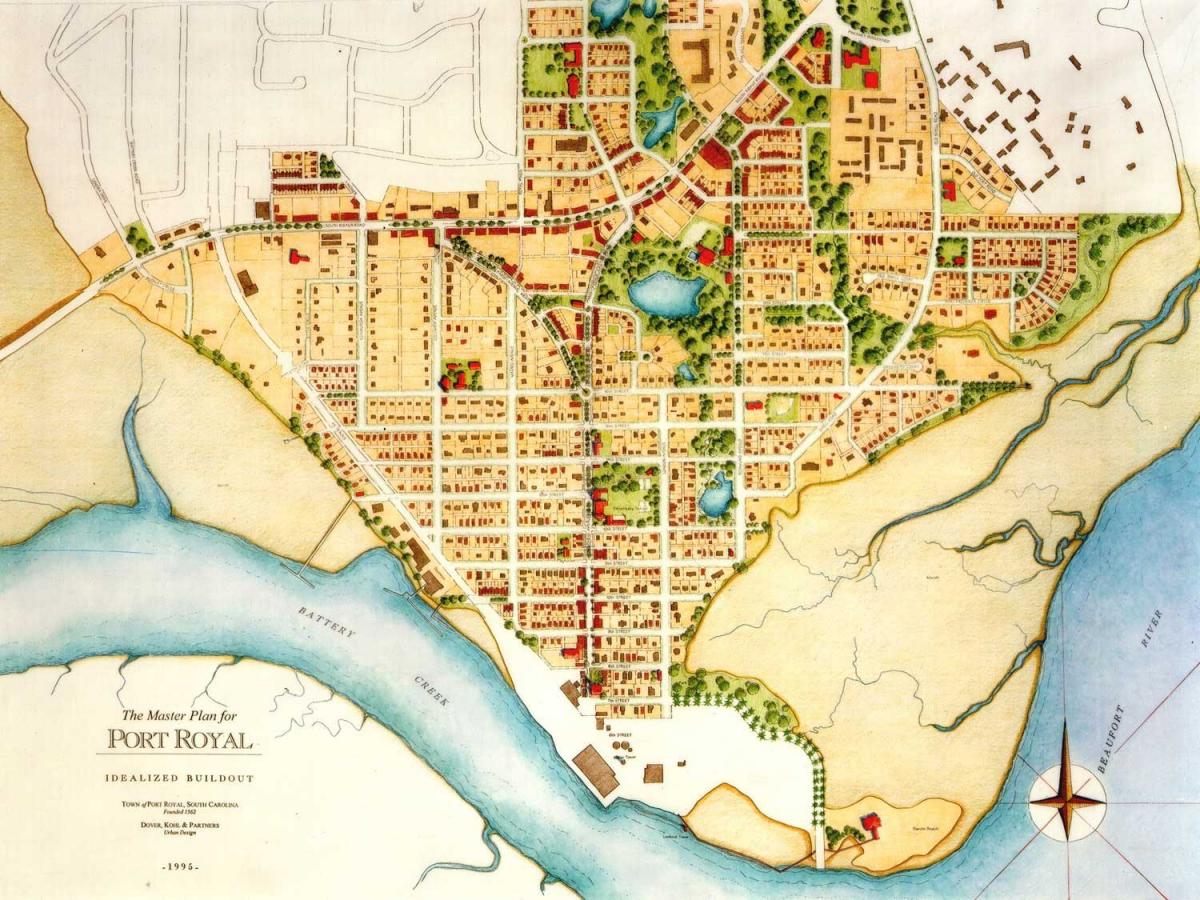
Five hundred plans of Dover and Kohl
Many urbanists are gathering at the iconic town of Seaside in Florida this weekend to award the annual Seaside Prize to the 2024 recipients, Victor Dover and Joseph Kohl, cofounders of Dover, Kohl & Partners in South Miami, Florida.
Kohl and Dover have been leaders of New Urbanism since CNU launched in 1993, and they are still in their prime, cranking out innovative plans and projects regularly. Since they started in 1987, the firm has completed 400-500 projects, with a hundred or more on the neighborhood scale or larger, they estimate.
Dover and Kohl are CNU fellows, and Dover is a former board president. CNU fellow and Public Square editor Robert Steuteville recently interviewed them on various topics related to urbanism. Below is a transcript edited for length and clarity.

Steuteville: How did you get started doing the kinds of projects that your firm has become known for over the years?
Kohl: When we started, we were not going to do greenfield projects, and we took that approach for five years. Our clients were cities, redevelopment agencies, and occasionally a private sector infill project, but we realized after a few years that it takes so long to get things moving and see results in the public sector. People asked, “Do you have any photographs of our work?” We had a few photos; a street here, an infill building there, some trees planted. That’s when we realized that if we wanted to see some real results, we would work on greenfield sites as well. We never gave up on the city work, it still makes us feel the warmest inside.
Dover: Glenwood Park (in the City of Atlanta) was a brownfield redevelopment project. It was a blank slate, but it had a concrete recycling plant on it. It was dusty and desolate, but it wasn’t in the middle of nowhere. Then there’s South Main (in Buena Vista, Colorado)—the site was in a town, between the existing downtown and the waterfront. It was used as a dump. I’On, another project we are proud of, had conventional suburban development on three sides (the fourth side being the marsh). None of these were leapfrog sprawl, they were infill sites, even though they had a lot of room to design the site as a whole. Port Royal, South Carolina, the little scrappy town, implemented our plan like crazy, mostly on scattered sites. We realized that local government can move fast when they want to—and not all blank slate sites are created equal.
Steuteville: The projects are infill, but they also have critical mass. You were not starting from scratch; you were building on the urbanism that already existed.
Dover: And, extending the existing street network into the site. And when you have a sizable site, it is not just the quantity of what you can do, it is also variety. In Glenwood Park, (developers) Charles Brewer and Katharine Kelley were determined to maximize the number of assets on offer there, from housing, to workplace, to commerce. The site is the smallest (20 acres) you could accurately describe as a neighborhood. You can get the variety society needs even if you don’t have hundreds of acres to work with.
Steuteville: Which is the project you are most proud of?
Kohl: I enjoy I’On (Mount Pleasant, South Carolina), which we did with DPZ, a joint effort. I enjoy going to I’On the most, because Vince Graham held so true to the historic patterns. He got builders to do details that we can’t seem to get from other builders, and do it in a way that worked for them financially. I also like Hammond’s Ferry, the project in North Augusta, Georgia. I like the way South Main is looking.
Dover: South Main is only 30 percent built, but It feels authentic and is being built slowly and carefully, in a frugal and market-based way. When it is quiet, it doesn’t feel empty, and when it is packed with people, it doesn’t feel crowded. When we started, Buena Vista had boarded-up storefronts. Now, the town is bustling; the storefronts are full of life. South Main had this wonderful effect on the main street of the historic town.

Port Royal is the little town that could. They got into it when New Urbanism wasn’t cool, and they were determined and implemented a ton, beautifully and humbly. It has stood the test of time.
I am very proud of Columbia Pike. Corridor projects are super hard. As corridor projects go, Columbia Pike is probably more implemented than any other I can name. It has made Arlington, Virginia, better.
Steuteville: Comparing urban design to making a movie, is the planner the screenwriter, and the client the director?
Kohl: The client is the producer.
Dover: The director and the production designer are the urban designer roles. The code writer, maybe, is the screenwriter, with the developer and local government leaders as executive producers and deciders on many things.
Steuteville: Can you name a project that failed to live up to its potential?
Kohl: Those were the ones that didn’t have a client with strong intentions. We tend not to remember them (laughs). Many start out right, and then the client listens to other consultants and makes changes. We see that when we look at an old Olmsted plan or John Nolen plan. If you just followed the plan, it would have been a lot better.
Dover: Eastgate Mall, which we thought would be the next big thing, was one of our first efforts in Chattanooga in the mid-90s. We planned the conversion of a failed mall to a mixed-use town center. They started by putting new facades on the old blank walls of department stores. It sprouted windows. One out-parcel was reconceived as a neighborhood square. They built the square, planted the grass, and opened a Starbucks facing it.
Kohl: It was actually the Starbucks that killed it, Victor. They built one side of the square, and on the other side they got Starbucks, and Starbucks said “we need our drive-through and parking” in front.
Dover: They demolished the square. It looks no better than it did in the mid-90s, and it is a failed project.

Steuteville: We have talked about the kinds of projects that you have repeated across the country. What are the areas of work or issues that are highly meaningful to you?
Kohl: I don’t think of it that way. I just wonder why I do what I do. I grew up in a suburban place, was stranded through high school without a car, and did not have much freedom. I remember visiting my grandmother in Milwaukee who never drove. They had a 50-foot-wide lot with a two-story house and a garage on the alley. I would walk with her to the grocery store and the drug store. And everybody knew her name and they talked to all the neighbors. People parked on the street under the canopy of trees. There was a nice sidewalk. Also, we (Victor and Joe) also lived in Alexandria, Virginia (in college). So when we came to Miami, and we started learning about the work of DPZ, it all just gelled. I like to see people have the opportunity to live where they don’t have to drive everywhere.
Dover: My answer is street design. It’s an obsession. It’s the one thing we can least afford to get wrong. And it is the one thing gotten wrong most often. It is very satisfying when you have an influence on it. It’s always a fight, but as hard as it is, it is indispensable because it changes people’s lives.
Steuteville: What have you been thinking about lately?
Dover: I have been thinking about parks. It shouldn’t take until you are 60 to realize the power of parks and master plans. This came out of our work in Lake Wales (Florida), because we inherited some old plans from 1925 by the Olmsted Brothers. The ancient conception of a park is like a square, but larger. There is that continuum from a plaza to green, square, park, regional park, and wilderness area. The Olmsteds flipped that around. The city is the park, and we create real estate opportunities within it.
Kohl: The other side of Lake Wales is what I have been thinking about. It seems like we are continually fighting the specialized developers who are willing to build a mixed-use community, but one of them will not put an apartment building next to a row of townhouses. They have to put the townhouses in one place, and the apartments in another. In Lake Wales, they are trying to fight sprawl. They are purchasing land to keep it open and telling the national builders, no we don’t want the products you are producing. I am curious to see how that shakes out. When we are talking about the right developers, they have to make a long-term commitment to a place.
Dover: I think we have a world full of habits and not all of them are good. And they all take a long time to fix. During the second CNU in Los Angeles, (CNU cofounder) Stefanos Polyzoides talked about the 200-year project of fixing urbanism in America. At the time, I was thinking what are you saying? Don’t tell them it will take 200 years. And now 30 years later, I realize this is going slow. It takes a long time. We may be old before we win.
Steuteville: You won Seaside Prize. What do you think about that, and where do you go from here?
Dover: My first reaction was, “Are you sure there hasn’t been some mistake?” It is an amazing honor. So many people have won it that we admire. My second thought was that, in recognizing our work, they were recognizing all of our great clients and collaborators—including all of the people who worked here over the years.
Kohl: We don’t see it as a lifetime achievement award. It has echoes of that, but we will keep doing what we have been doing. I plan to expire over the top of the coloring of an illustrative plan.
Steuteville: Is that the equivalent of dying with your boots on?
Kohl: Exactly.




